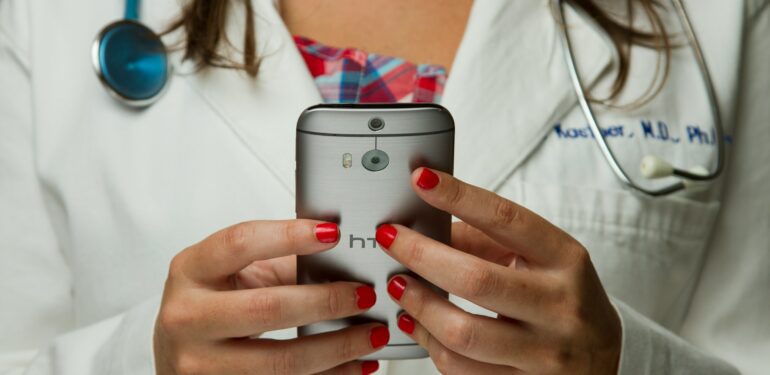The more the healthcare sector adopts digital platforms and applications, the more crucial user experience (UX) becomes. While healthcare organizations have been notoriously slow to adopt new technologies, there has been a surge of digitalization in the past few years, which means a significant increase in digital data used across the industry.
Guest post by Katie Brenneman.
UX is about making sure that data and interfaces are used in a way that benefits the end user. It’s about generating more value for those who are engaging with healthcare services to improve outcomes.
Already, we are seeing a significant change in healthcare settings and interactions that are improving patient experiences. If this trend continues, it can revolutionize the industry and completely transform the future of healthcare.
Understanding Healthcare UX
UX refers to how digital systems and interfaces are designed with the end user in mind. In healthcare, UX is specifically focused on creating user-friendly experiences for patients, administrators, and healthcare professionals to optimize processes and improve patient satisfaction.
User experience is important in any industry, but UX matters even more in healthcare because poor UX design can have serious consequences. For example, in the retail industry, poor UX might mean that a customer decides not to purchase a product, which simply means a lost sale. However, in healthcare, poor UX could lead to inadequate patient care, which could put a patient’s health at risk.
Consider a mobile healthcare app designed for people with diabetes. If that app has a poor UX design and doesn’t collect or properly analyze user data, it could lead to a patient getting the wrong medical advice.
On a more positive note, if healthcare systems and interfaces have good UX design, they can significantly improve patient outcomes. In that sense, good healthcare UX could save lives.
How UX Design and Data is Changing Healthcare Interfaces
When we combine advanced digital healthcare technologies with UX design and big data, we have the power to completely transform the healthcare industry for the good in the following ways.
1. Seamless, Personalized Experiences
With healthcare UX, access to care becomes easier and the experiences can be more personalized to each patient’s individual needs. Things like telehealth services, contact-free voice user interfaces, and healthcare chatbots are all designed using UX to improve when, where, and how patients can access the care they need. This enables healthcare organizations to improve user-friendliness without sacrificing quality of care.
This also ensures patients are getting more personalized care based on their unique needs. For example, some patients who use injectable drugs for treating conditions such as arthritis and diabetes may need a safe way to dispose of needles at home. UX data could be analyzed to identify which patients have this need and provide them with resources such as sharp mail-back programs, which can provide additional safety and convenience when disposing of these hazardous materials.
2. Better Patient Care
Big data in UX design also gives healthcare professionals instant access to greater amounts of data about a patient’s medical history. This not only enables them to deliver the right solutions and treatments to patients more quickly, but it also enables them to make smarter decisions when determining how to treat a patient.
UX data collected from healthcare interfaces can be analyzed using AI-powered software that can help doctors with disease detection and diagnosis. For example, numerous medical apps are now available for doctors that make diagnosing and delivering care to patients more efficient. Some of the latest apps include VisualDX, Epocrates, DynaMed, and MDCalc.
From an accessibility standpoint, interfaces can also be improved using UX for patients with certain health conditions to access the quality care they need, such as those with visual or hearing impairments caused by genetic disorders. This can include using design and coding that allows users to use assistive devices, such as screen readers when navigating a website, for example, or a mobile app.
3. Improved Research and Development
Much of the data that comes from UX-designed interfaces is also helping to improve medical research and development. During the COVID-19 pandemic, for example, certain apps and the data they obtained from users enabled medical researchers to better understand the disease. This then helped with the development of vaccines, medicines, and procedures to help better manage and treat the disease.
This process of using data tools can be used for just about any health condition, including in-home healthcare settings, and can help make new discoveries and develop better treatments to improve patient outcomes in the future. It could also help with more targeted and safer interventions when there are massive disease outbreaks.
Safely Putting Patients First
Although UX in healthcare has the potential to bring all of the benefits mentioned above, it is important to strike a balance between providing a personalized user experience and prioritizing patient safety. Hackers often target healthcare information – in fact, in 2023 alone, it is estimated at least 133 million healthcare records were exposed. Because UX data is tangential to, if not the same as, in some cases, healthcare data itself, developers must emphasize security when they are creating healthcare interfaces.
Oftentimes, this means striking a balance between providing patients with the personalized care that they need, while also recognizing the risks that can come with sharing this data through an interface. Some solutions to this issue include opting for encrypted messaging systems or requiring additional consent from patients to disclose information outside of the application. In addition, developers should work to ensure that their platforms are HIPAA compliant.
Finally, developers should also ensure that all staff members who have access to this data are well-trained on common methods that are used to hack into databases. For instance, ransomware attacks can be prevented by training employees on the dangers of, and how to recognize, common methods of gaining access to this data, such as phishing emails. Organizations should also have an in-depth response plan in case a data breach does occur.
Compliance and security aren’t just about doing good business either – in addition to keeping patients safe, it also ensures that your business is not violating any laws. And patient privacy should also trump getting new customers. A recent example of this is the controversy surrounding BetterHelp. The FTC has recently declared that BetterHelp violated its users’ privacy by taking their data and using it to sell targeted ads, in an attempt to gain additional customers.
While many apps will not go to this extreme, users must be aware of if, and when, any of their data will be used for third-party marketing purposes. In some instances, healthcare app developers may also choose to partner with research facilities and scientists to take patient data and use it to create medical breakthroughs. Again, patients must be informed – ideally, they should have the ability to opt in and out – if their data will be used in this way, and applications must ensure that they are not collecting any data that is not necessary to these studies.
Ultimately, creating an application which takes the above factors into account takes time, but is ultimately worth it for user trust.
Healthcare UX and big data have the power to drive better healthcare outcomes, whether it’s improving patient care, making internal processes more efficient, or enabling more informed decision-making. As the healthcare industry continues to experience rapid growth with advanced technologies, good UX design – and designing great applications – will become even more critical to ensure safety and efficiency and improve quality of life.


